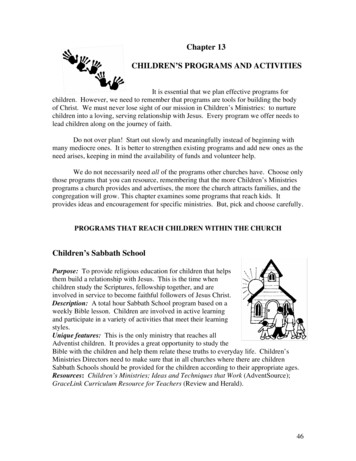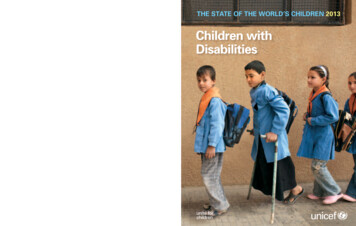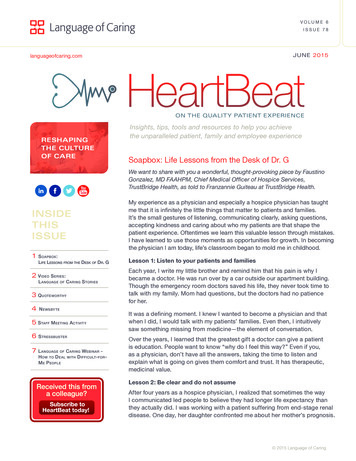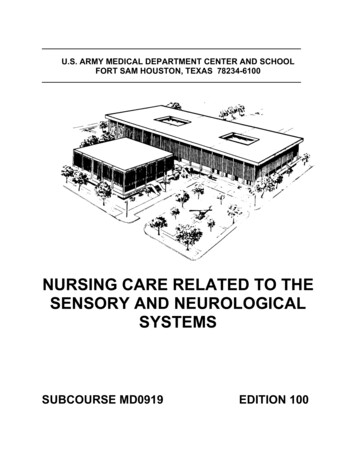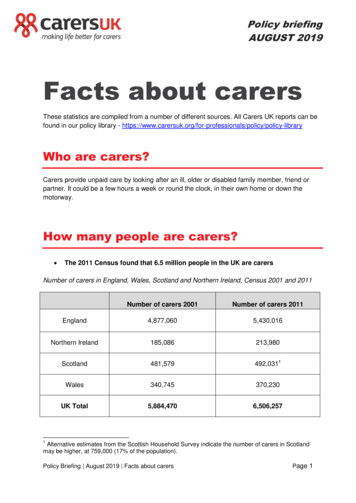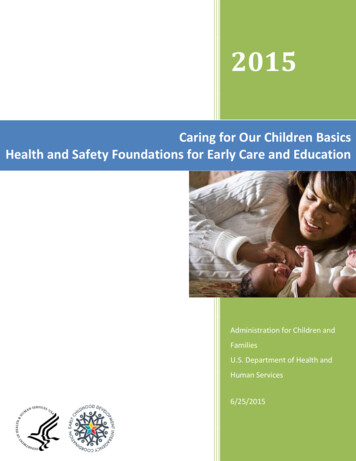
Transcription
2015Caring for Our Children BasicsHealth and Safety Foundations for Early Care and EducationAdministration for Children andFamiliesU.S. Department of Health andHuman Services6/25/2015
ContentsAcknowledgements . 4Introduction . 5Staffing . 81.1.1.1-1.1.1.5 Ratios for Centers and Family Child Care Homes . 81.2.0.2 Background Screening . 81.4.1.1/1.4.2.3 Pre-service Training/Orientation . 91.4.3.1 First Aid and CPR Training for Staff . 91.4.4.1/1.4.4.2 Continuing Education for Directors, Caregivers/Teachers in Centers, andFamily Child Care Homes . 91.4.5.2 Child Abuse and Neglect Education . 9Program Activities for Healthy Development . 102.1.1.4 Monitoring Children's Development/Obtaining Consent for Screening . 102.1.2.1/2.1.3.1 Personal Caregiver/Teacher Relationships for Birth to Five-Year-Olds . 102.2.0.1 Methods of Supervision of Children . 102.2.0.4 Supervision near Water. 102.2.0.8 Preventing Expulsions, Suspensions, and Other Limitations in Services . 112.2.0.9 Prohibited Caregiver/Teacher Behaviors . 11Health Promotion and Protection . 123.1.3.1 Active Opportunities for Physical Activity . 123.1.4.1 Safe Sleep Practices and SIDS Risk Reduction . 123.1.5.1 Routine Oral Hygiene Activities . 123.2.1.4 Diaper Changing Procedure . 123.2.2.1 Situations that Require Hand Hygiene . 133.3.0.1 Routine Cleaning, Sanitizing, and Disinfecting . 133.2.3.4 Prevention of Exposure to Blood and Body Fluids . 133.4.1.1 Use of Tobacco, Alcohol, and Illegal Drugs . 133.4.3.1 Emergency Procedures . 143.4.4.1 Recognizing and Reporting Suspected Child Abuse, Neglect, and Exploitation . 143.4.4.3 Preventing and Identifying Shaken Baby Syndrome and Abusive Head Trauma . 143.4.5.1 Sun Safety Including Sunscreen . 143.4.6.1 Strangulation Hazards . 141
3.5.0.1 Care Plan for Children with Special Health Care Needs . 143.6.1.1 Inclusion/Exclusion/Dismissal of Children . 153.6.1.4 Infectious Disease Outbreak Control . 153.6.3.1/3.6.3.2 Medication Administration and Storage . 153.6.3.3 Training of Caregivers/Teachers to Administer Medication . 16Nutrition and Food Service . 164.2.0.3 Use of U.S. Department of Agriculture (USDA), Child and Adult Care Food Program(CACFP) Guidelines. 164.2.0.6 Availability of Drinking Water . 164.2.0.10 Care for Children with Food Allergies . 164.3.1.3 Preparing, Feeding, and Storing Human Milk . 174.3.1.5 Preparing, Feeding, and Storing Infant Formula . 174.3.1.9 Warming Bottles and Infant Foods . 184.5.0.10 Foods that Are Choking Hazards . 184.8.0.1 Food Preparation Area Access . 184.9.0.1 Compliance with U.S. Food and Drug Administration (FDA) Food Code and State andLocal Rules. 18Facilities, Supplies, Equipment, and Environmental Health . 185.1.1.2 Inspection of Buildings . 185.1.1.3 Compliance with Fire Prevention Code. 185.1.1.5 Environmental Audit of Site Location . 185.1.6.6 Guardrails and Protective Barriers . 195.2.4.2 Safety Covers and Shock Protection Devices for Electrical Outlets . 195.2.4.4 Location of Electrical Devices near Water . 195.2.8.1 Integrated Pest Management . 195.2.9.1 Use and Storage of Toxic Substances. 195.2.9.5 Carbon Monoxide Detectors . 195.3.1.1/5.5.0.6/5.5.0.7 Safety of Equipment, Materials, and Furnishings . 195.3.1.12 Availability and Use of a Telephone or Wireless Communication Device . 205.4.5.2 Cribs and Play Yards . 205.5.0.8 Firearms. 215.6.0.1: First Aid and Emergency Supplies . 21Play Areas/Playgrounds and Transportation . 212
6.1.0.6/6.1.0.8/6.3.1.1 Location of Play Areas near Bodies of Water/ Enclosures for OutdoorPlay Areas/Enclosure of Bodies of Water . 216.2.3.1 Prohibited Surfaces for Placing Climbing Equipment . 216.2.5.1 Inspection of Indoor and Outdoor Play Areas and Equipment . 226.3.2.1 Lifesaving Equipment . 226.3.5.2 Water in Containers . 226.5.1.2 Qualifications for Drivers . 226.5.2.2 Child Passenger Safety . 236.5.2.4 Interior Temperature of Vehicles . 236.5.3.1 Passenger Vans. 23Infectious Disease . 237.2.0.1 Immunization Documentation . 237.2.0.2 Unimmunized Children . 247.2.0.3 Immunization of Caregivers/Teachers . 24Policies . 259.2.4.1 Written Plan and Training for Handling Urgent Medical Care or Threatening Incidents. 259.2.4.3/9.2.4.5 Disaster Planning, Training and Communication/Emergency and EvacuationDrills . 259.2.4.7 Sign-In/Sign-Out System . 259.2.4.8 Authorized Persons to Pick Up Child . 269.4.1.12 Record of Valid License, Certificate, or Registration of Facility or Family Child CareHome . 269.4.2.1 Contents of Child Records . 2610.4.2.1 Frequency of Inspections for Child Care Centers and Family Child Care Homes . 26Resources Consulted in Development . 273
AcknowledgementsCaring for our Children Basics is based on Caring for Our Children: National Health and SafetyPerformance Standards; Guidelines for Early Care and Education Programs, Third Edition. Wewould like to acknowledge the extensive work of the American Academy of Pediatrics;American Public Health Association; National Resource Center for Health and Safety in ChildCare and Early Education; and Maternal and Child Health Bureau, Department of Health andHuman Services in developing these standards. We would also like to especially thank thefollowing experts for their help in this effort:Abbey Alkon, RN, Ph.D.School of NursingUniversity of California, San FranciscoJudy CollinsConsultantRichard Fiene, Ph.D.Research Institute for Key IndicatorsWalter Gilliam, Ph.D.Edward Zigler Center in Child Developmentand Social PolicyYale University Child Study CenterDanette Swanson Glassy, MD, FAAPAmerican Academy of PediatricsPauline D. KochKoch ConsultingMarilyn Krajicek, Ed.D., RN, FAANNational Resource Center for Health andSafety in Child Care and Early EducationCollege of NursingUniversity of Colorado DenverBeverly Schmalzreid, Ph.D.Department of Child DevelopmentSouth Texas CollegeNancy Von Bargen, MSOffice of Child Care National Center forChild Care Quality ImprovementJeanne VanOrsdal, M. Ed.Barbara Hamilton, MAMaternal and Child Health BureauHealth Resources and ServicesAdministrationU.S. Department of Health and HumanServicesEarly Education and Child Care InitiativesAmerican Academy of PediatricsMarcus WilliamsNational Association for RegulatoryAdministration4
IntroductionEvidence continues to mount that demonstrates the profound influence children’s earliestexperiences have on later success. Nurturing and stimulating care given in the early years buildsoptimal brain architecture that allows children to maximize their potential for learning.Interventions in the first years of life are capable of altering the course of development andshift the odds for those at risk of poor outcomes toward more adaptive ones.To meet the needs of our nation’s most vulnerable children and families, the early care andeducation programs administered by the Administration for Children and Families (ACF) aredesigned to both provide enriching early childhood experiences that promote the long-termsuccess of children and assist low-income working parents with the cost of child care. Inpartnership with families, all early care and education programs should support children'sneeds and age-appropriate progress across domains of language and literacy development;cognition and general knowledge; approaches to learning; physical health and well-being andmotor development, and social and emotional development that will improve readiness forkindergarten. Head Start, Early Head Start, pre-Kindergarten, and child care programs aim tosupport the ability of parents, teachers, child care providers and other community members tointeract positively with children in stable and stimulating environments to help create a sturdyfoundation for later school achievement, economic productivity, and responsible citizenship.ACF strives to achieve the following goals in all early childhood programs: Build successful Early Learning and Development Systems across Early Head Start, HeadStart, child care, and pre-Kindergarten. Promote high quality and accountable early learning and development programs for allchildren. Ensure an effective early childhood workforce. Improve the physical, developmental, mental health, and social well-being of children inearly learning and development settings. Promote family engagement and support in a child’s development with the recognitionthat parents are their children's primary teachers and advocates. Build on the strengths and address the needs of culturally and linguistically diversechildren and families. Improve the health and safety of early learning and development settingsWhile high quality early care and education settings can have significant developmentalbenefits and other positive long term effects for children well into their adult years, poorquality settings can result in unsafe environments that disregard children's basic physical andemotional needs leading to neglect, toxic stress, injury, or even death. As a result, it is notsurprising that health and safety has been identified in multiple parent surveys as one of themost important factors to consider when evaluating child care options (Shlay, 2010). Health and5
safety practices provide the foundation on which states and communities build quality earlycare and education settings.Licensing of center-based care and family child care homes is a process that establishes theminimum requirements necessary to protect the health and safety of children in care. Statelicensing requirements are regulatory requirements, including registration or certificationrequirements, established under State law necessary for a provider to legally operate andprovide child care services.From 2009 to 2011, more than half of states made changes to licensing regulations for centerbased care and family child care homes. For example, states increased the pre-service trainingrequirements for center directors, and increased the number of ongoing training hours for allcenter staff roles, as well as family child care providers. Specifically, 47 States require centerstaff and 37 States require family child care providers to complete first aid training. Withrespect to CPR, 46 States require training of center staff and 36 require it of family child careproviders. More than half of States require center staff to complete training on child abuse andneglect (27 States) or the prevention of communicable diseases (25 States). The number ofStates requiring fingerprint checks of federal records and checks of sex offender registries hasincreased since 2007. All States that license centers and more than 85% that license family childcare homes have requirements about the nutritional content of meals and snacks served tochildren. States have added requirements about fences for outdoor space, transportation, andemergency preparedness, and more States prohibit firearms in child care centers (Office ofChild Care National Center on Child Care Quality Improvement and National Association forRegulatory Administration, 2013).Great progress has been made in States to safeguard children in out of home care, yet morework must be done to ensure children can learn, play, and grow in settings that are safe andsecure. States vary widely in the number and content of health and safety standards as well asthe means by which they monitor compliance. Some early care and education programs mayreceive no monitoring while others receive multiple visits. Further, some programs who receivefunding from multiple sources may receive repeated monitoring visits that evaluate programsagainst complicated, and sometimes conflicting, standards. While there are differences inhealth and safety requirements by funding stream (e.g. Head Start, Child Care DevelopmentFund, Individuals with Disabilities Education Act, and Title I), early childhood program type (e.g.center-based, family child care homes) and length of time in care, there are basic standardsthat must be in place to protect children no matter what type of variation in program. Untilnow, there has been no federal guidance that supports States in creating basic, consistenthealth and safety standards across early care and education settings.ACF is pleased to announce Caring for Our Children Basics: Health and Safety Foundations forEarly Care and Education. Caring for our Children Basics represents the minimum health andsafety standards experts believe should be in place where children are cared for outside of theirhomes. Caring for our Children Basics seeks to reduce the conflicts and redundancy found inprogram standards linked to multiple funding streams. Caring for our Children Basics should not6
be construed to represent all standards that should be present to achieve the highest quality ofcare and early learning. For example, the caregiver training requirements outlined in thesestandards are designed only to prevent harm to children, not to ensure their optimaldevelopment and learning.Caring for our Children Basics is the result of work from both federal and non-federal expertsand is founded on Caring for Our Children: National Health and Safety Performance Standards;Guidelines for Early Care and Education Programs, Third Edition, created by the AmericanAcademy of Pediatrics; American Public Health Association; and National Resource Center forHealth and Safety in Child Care and Early Education with funding from the Maternal and ChildHealth Bureau. The Office of Child Care, Office of Head Start, Office of the Deputy AssistantSecretary for Early Childhood, and the Maternal and Child Health Bureau were instrumental inthis effort. Although use of Caring for our Children Basics is not federally required, the set ofstandards was posted for public comment in the Federal Register to provide ACF with practicalguidance to aid in refinement and application. The standards, regulations, and guidance withwhich Caring for our Children Basics was produced are located at the end of this document.Quality care can be achieved with consistent, basic health and safety practices in place. Thoughvoluntary, ACF hopes Caring for Our Children Basics will be a helpful resource for states andother entities as they work to improve health and safety standards in both licensing and qualityrating improvement systems (QRIS). As more states build their QRIS, it is hoped that Caring forOur Children Basics will support continuous quality improvement in programs as they move tohigher levels of quality and improve the overall health and well-being of all children in out-ofhome settings. In addition, ACF anticipates Caring for Our Children Basics will support efficiencyand effectiveness of monitoring systems for early care and education settings. A commonframework will assist the Nation in working towards and achieving a more consistentfoundation for quality upon which families can rely.7
Staffing1.1.1.1-1.1.1.5 Ratios for Centers and Family Child Care HomesAppropriate ratios should be kept during all hours of program operation. Children with specialhealth care needs or who require more attention due to certain disabilities may requireadditional staff on-site, depending on their needs and the extent of their disabilities.In center-based care, child-provider ratios should be determined by the age of the majority ofchildren and the needs of children present.Age 12 months13-23 months24-35 months3-year-olds4- to 5-year-oldsChild Care CentersMaximum Child: Provider Ratio4:14:14:1-6:19:110:1In family child care homes, the provider’s own children under the age of 6, as well as any otherchildren in the home temporarily requiring supervision, should be included in the child:provider ratio. In family child care settings where there are mixed age groups that includeinfants and toddlers, a maximum ratio of 6:1 should be maintained and no more than two ofthese children should be 24 months or younger. If all children in care are under 36 months, amaximum ratio of 4:1 should be maintained and no more than two of these children should be18 months or younger. If all children in care are 3 years old, a maximum ratio of 7:1 should bepreserved. If all children in care are 4 to 5 years of age, a maximum ratio of 8:1 should bemaintained.1.2.0.2 Background ScreeningAll caregivers/teachers and staff in early care and education settings (in addition to anyindividual age 18 and older, or a minor over age 12 if allowed under State law and if aregistry/database includes minors, residing in a family child care home) should undergo acomplete background screening upon employment and once at least every five yearsthereafter. Screening should be conducted as expeditiously as possible and should becompleted within 45 days after hiring. Caregivers/teachers and staff should not haveunsupervised access to children until screening has been completed. Consent to thebackground investigation should be required for employment consideration. Thecomprehensive background screening should include the following:a) A search of the State criminal and sex offender registry or repository in the State wherethe child care staff member resides, and each State where such staff member residedduring the preceding 5 years;8
b) A search of State-based child abuse and neglect registries and databases in the Statewhere the child care staff member resides, and each State where such staff memberresided during the preceding 5 years; andc) A Federal Bureau of Investigation fingerprint check using Next Generation Identification.Directors/programs should review each employment application to assess the relevancy of anyissue uncovered by the complete background screening, including any arrest, pending criminalcharge, or conviction, and should use this information in employment decisions in accordancewith state laws.1.4.1.1/1.4.2.3 Pre-service Training/OrientationBefore or during the first three months of employment, training and orientation should detailhealth and safety issues for early care and education settings including, but not limited to,typical and atypical child development; pediatric first aid and CPR; safe sleep practices,including risk reduction of Sudden Infant Death Syndrome/Sudden Unexplained Infant Death(SIDS/SUID); poison prevention; shaken baby syndrome and abusive head trauma; standardprecautions; emergency preparedness; nutrition and age-appropriate feeding; medicationadministration; and care plan implementation for children with special health care needs.Caregivers/teachers should complete training before administering medication to children. SeeStandard 3.6.3.3 for more information. All directors or program administrators andcaregivers/teachers should document receipt of training.Providers should not care for children unsupervised until they have completed training inpediatric first aid and CPR; safe sleep practices, including risk reduction of Sudden Infant DeathSyndrome/Sudden Unexplained Infant Death (SIDS/SUID); standard precautions for theprevention of communicable disease; poison prevention; and shaken baby syndrome/abusivehead trauma.1.4.3.1 First Aid and CPR Training for StaffAll staff members involved in providing direct care to children should have up-to-datedocumentation of satisfactory completion of training in pediatric first aid and currentcertification in pediatric CPR. Records of successful completion of training in pediatric first aidand CPR should be maintained in the personnel files of the facility.1.4.4.1/1.4.4.2 Continuing Education for Directors, Caregivers/Teachers in Centers,and Family Child Care HomesDirectors and caregivers/teachers should successfully complete intentional and sequentialeducation/professional development in child development programming and child health,safety, and staff health based on individual competency and any special needs of the children intheir care.1.4.5.2 Child Abuse and Neglect EducationCaregivers/teachers should be educated on child abuse and neglect to establish child abuse andneglect prevention and recognition strategies for children, caregivers/teachers, andparents/guardians. The education should address physical, sexual, and psychological or9
emotional abuse and neglect. Caregivers/teachers are mandatory reporters of child abuse orneglect. Caregivers/teachers should be trained in compliance with their state's child abusereporting laws.Program Activities for Healthy Development2.1.1.4 Monitoring Children's Development/Obtaining Consent for ScreeningPrograms should have a process in place for age-appropriate developmental and behavioralscreenings for all children at the beginning of a child's enrollment in the program, at least yearlythereafter, and as developmental concerns become apparent to staff and/orparents/guardians. Providers may choose to conduct screenings, themselves; partner with alocal agency/health care provider/specialist who would conduct the screening; or work withparents in connecting them to resources to ensure that screening occurs. This process shouldconsist of parental/guardian education, consent, and participation as well as connection toresources and support, including the primary health care provider, as needed. Results ofscreenings should be documented in child records.2.1.2.1/2.1.3.1 Personal Caregiver/Teacher Relationships for Birth to Five-Year-OldsPrograms should implement relationship-based policies and program practices that promoteconsistency and continuity of care, especially for infants and toddlers. Early care and educationprograms should provide opportunities for each child to build emotionally secure relationshipswith a limited number of caregivers/teachers. Children with special health care needs mayrequire additional specialists to promote health and safety and to support learning.2.2.0.1 Methods of Supervision of ChildrenIn center-based programs, caregivers/teachers should directly supervise children under age 6by sight and sound at all times. In family child care settings, caregivers should directly supervisechildren by sight or sound. When children are sleeping, caregivers may supervise by sound withfrequent visual checks.Developmentally appropriate child-to-staff ratios should be met during all hours of operation,and safety precautions for specific areas and equipment should be followed. Children under theage of 6 should never be inside or outside by themselves.2.2.0.4 Supervision near WaterConstant and active supervision should be maintained when any child is in or around water.During swimming and/or bathing where an infant or toddler is present, the ratio should alwaysbe one adult to one infant/toddler. During wading and/or water play activities, the supervisingadult should be within an arm’s length providing “touch supervision.” Programs should ensurethat all pools have drain covers that are used in compliance with the Virginia Graeme BakerPool and Spa Safety Act.10
2.2.0.8 Preventing Expulsions, Suspensions, and Other Limitations in ServicesPrograms should have a comprehensive discipline policy that includes developmentallyappropriate social-emotional and behavioral health promotion practices as well as disciplineand intervention procedures that provide specific guidance on what caregivers/teachers andprograms should do to prevent and respond to challenging behaviors. Programs should ensureall caregivers/teachers have access to pre- and in-service training on such practices andprocedures. Practices and procedures should be clearly communicated to all staff, families, andcommunity partners, and implemented consistently and without bias or discrimin
staff and 37 States require family child care providers to complete first aid training. With respect to CPR, 46 States require training of center staff and 36 require it of family child care providers. More than half of States req



